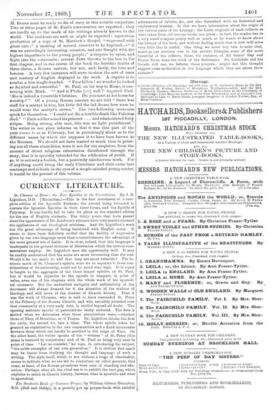CURRENT LITERATURE.
St. Clement ot Rome : the Two Epistles to the Corinthians. By J. B. Lightfoot, D.D. (Macmillan.)—This is the first instalment of a com- plete edition of the Apostolic Fathers ; the second being intended to contain the Ignatian Epistles in their three forms, and the Epistle of Polycarp. It can hardly fail to take its place as the standard edition for the use of English students. The thirty years that have passed since the appearance of Dr. Jacobson's volumes have very much increased the appliances of our theological criticism. And Dr. Lightfoot's work has the great advantage of being furnished with English notes. It seems to have been definitely settled that the facility of expression given by our own language more than counterbalances the advantage of the more general use of Latin. It is clear, indeed, that this language is inadequate to the greater richness of illustration which the newest com- mentators employ. Dr. Lightfoot uses his opportunity well. It may be readily understood that his notes are more interesting than the text. Would it be too much to add that they are more valuable ? The in- trinsic merit of St. Clement's epistle, were we to separate it from con- siderations of its authorship, could not be rated very high. It is equal in length to the aggregate of the three longer epistles of St. Paul, but it would be injustice to the apostle to compare, in point of value, even one of his chapters with the whole work of his apostoli- cal successor. But the undoubted antiquity and authenticity of the document will always demand for it the attention of the student of theology, and still more of the student of Church history. That it was the work of Clemens, who is said to have succeeded St. Peter in the Primacy of the Roman Church, and who certainly presided over that community at a very early date, is settled beyond all doubt. The opening sentence speaks of persecutions lately endured. The date is settled when we determine what these persecutions were,—whether those of Nero, of Domitian, or of Trajan. Dr. Lightfoot thinks the first too early, the second too late a time. The whole epistle takes for granted an organization in the two communities and a fixed intercourse between them which can hardly be ascribed to the reign of Nero. On the other hand, the writer speaks of the " witness " of St. Peter (this name is restored by conjecture) and of St. Paul as being very near in point of time. "Let us consider," he says, in introducing the subject, "the noble examples of our own generation." It is obvious that much may be learnt from studying the thought and language of such a writing. The style itself, which is not without a tinge of classicality, seems to indicate what we are led to conjecture on other grounds, that some, at least, of the Roman proselytes were men of standing and edu- cation. Perhaps, after all, the chief use is to exhibit the vast gap, which explains so much in Church history, between what is apostolic and what is apostolical.


































 Previous page
Previous page